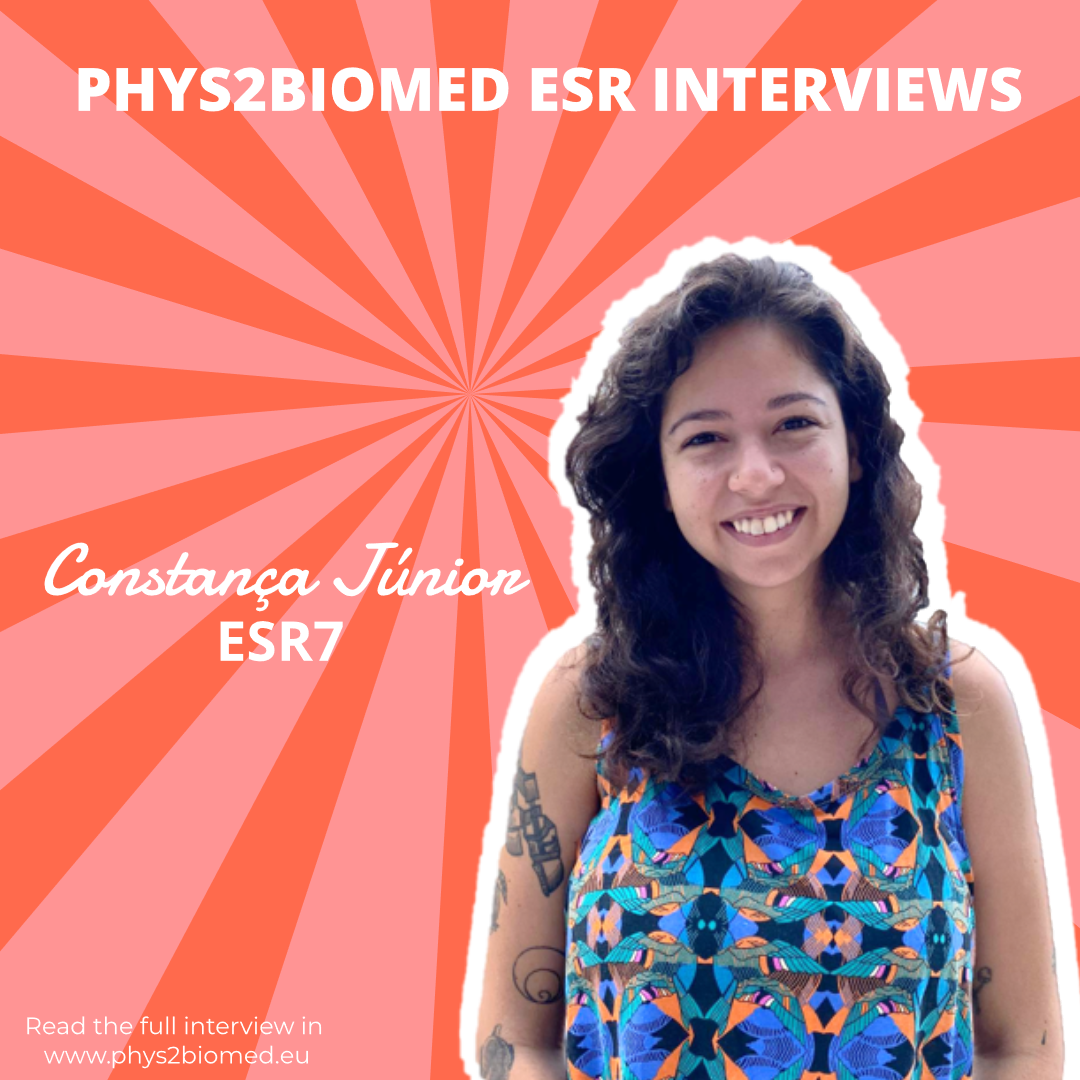ESR7. Constança Júnior
Short biographic note
I got my MSc. degree in Biomedical Engineering at Técnico Lisboa - University of Lisbon in 2017. My Master thesis was developed in collaboration with the Lensen Lab at the Technische Universitat Berlin and focused on the development of novel nanocomposite biomaterials based on PEG gels to promote cell adhesion.
I, then was part of a European Voluntary Service project in Nicosia, Cyprus, where I had the opportunity to work with people from all sorts of different backgrounds and had the chance to grow; not only as a person but as a European Citizen.
When the project finished, I started working as a software developer for an automotive industry company.
Currently I am working on the Phys2BioMed project as ESR7 at the Institute of Biotechnology of Catalonia in Barcelona, Investigating viscoelastic properties of tissue and extracellular matrix by the mean of Atomic Force Microscopy.
Project title
Tissue and extracellular matrix rheology in lung diseases assessed by AFM
Start date
1st June 2019
Beneficiary
Objectives
Expected results
Mouse model of lung cancer for the study of the mechanical properties of fresh parenchymal tissue and ECM de-cellularised samples. Standardised protocols to de-cellularize lung tissue to obtain a cellular ECM samples for mechanical measurements. Standardised protocols for immobilisation tissue samples for AFM testing. Characterisation of the viscoelastic properties of fresh parenchymal tissue and acellular ECM in healthy and cancer lung regions. Viscoelastic models of ECM and tissues. This ESR is shared with INSERM in a pilot joint doctorate project.
Planned secondments
1. UB, M. Radmacher (month 6, 3 months). Standardised procedures for AFM frequency measurements. 2. TMT-C2RC, M.-C. Copin (month 11, 1 month). Preparation of samples for the AFM analysis. 3. UMIL, A. Podestà (month 12, 2 months). AFM rheological measurements on ECM samples by means of custom colloidal probes. 4. INSERM, F. Rico (month 18, 1 months). Models of tissue rheology. 5. FAU, W. Goldmann (month 28, 3.5 months). Correlation between mechanics of cells by AFM grown on micro-patterns of varying size and mechanics of suspended cells using microfluidics.
ESR7 is a joint PhD project (IBEC/INSERM).
Publications
-
Baseline Stiffness Modulates the Non-Linear Response to Stretch of the Extracellular Matrix in Pulmonary Fibrosis. Constança Júnior, Maria Narciso, Esther Marhuenda, Isaac Almendros, Ramon Farré, Daniel Navajas, Jorge Otero and Núria Gavara. Int. J. Mol. Sci. 2021, 22(23), 12928; https://doi.org/10.3390/ijms222312928
Interview

Question 1: Where are you from and where are you conducting your research now?
Constança: I’m from Portugal and I am currently conducting my research in Barcelona.
Subquestion: Tell us about your background. (Ex.: Bioengineer with a masters in biomechanics and biomedical devices).
Constança: So, I completed an integrated masters on biomedical engineering and I did my specialization on cell and tissue engineering.
Question 2: Can you describe your project in one sentence?
Constança: Extracellular matrix rheology assessed by AFM.
Question 3: What do you think are the next big improvements to be made in your field of expertise?
Constança: I guess automating AFM measurements and making them usable as a diagnosis tool.
Question 4: Why did you choose a research path?
Constança: I didn’t choose the research path, the research path chose me (laughs). Well, because I like flexibility in the way I work and this project in specific was a good opportunity for me to enter academia since we are embedded in a network where we can share and work and develop
Question 5: What’s the best and worst part about academia?
Constança: The best part is the flexibility where you can manage your own project, which is nice. The worst part is probably the recognition you get out of it, in terms of scholarship, investments, money in your work is not taken seriously if it doesn’t have an obvious profitable application.
Question 6: What 3 traits do you believe are most useful to succeed in this occupation?
Constança: The first thing is perseverance - you really need to be focused and want to develop what you want to do, since there are a lot of challenges that need to be overcame. Patience to deal with different people and different problems that arise. The last one is resourceful because a lot of times you don’t have the resources you need and you still need to make it happen.
Question 7: Give me an example of when you failed at something. How did you react and how did you overcome failure?
Constança: I never fail! I’m joking… (thinking) Can we skip this question…? I can’t remember when I fail, I delete those memories.
Question 8: If you were stranded on a deserted island, what three things would you have and why?
Constança: Hm… My phone I guess for obvious reasons. Assuming there is food on the island, I would need a lighter or some matches to make fire for survival purposes… and a jacket!
Question 9: What’s one thing you love about Barcelona and one thing you don’t like?
Constança: One thing I love about Barcelona is the weather because it is nice all year round. One thing I hate about Barcelona is that it smells bad.
Subquestion: Can you do the same for your home city (insert name here)?
Constança: One thing I love is also the weather… And one thing I hate is that there are not many people there – it gets boring.
Question 10: If we finish this interview and you step outside and find a lottery ticket that ends up winning €10 million. What would you do?
Constança: I would cash it immediately and invest it so I can turn 10 million into 100 million.
 Biomechanics in health and disease:
Biomechanics in health and disease: